Educational Permafrost Gallery (EPPG) by Skip Walker
Skip Walker, Alaska Geobotany Center
Please attribute photo credit and copyright to Skip Walker, unless otherwise indicated.
Please click on an image to see a larger version of the permafrost feature!
|
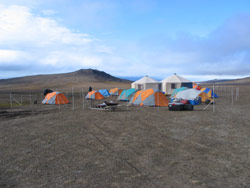 Camp at Isachsen. Evening lectures were conducted in the large yurt on the right and the smaller yurt was lab space. The electric fence around the camp and two native hunters from Sachs Harbor protected the camp from polar bears. Camp at Isachsen. Evening lectures were conducted in the large yurt on the right and the smaller yurt was lab space. The electric fence around the camp and two native hunters from Sachs Harbor protected the camp from polar bears.
Photo credit: Skip Walker
|
|
|
|
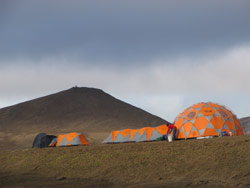 Camp for the Arctic Field Ecology course. Camp for the Arctic Field Ecology course.
Photo credit: Skip Walker
|
|
|
|
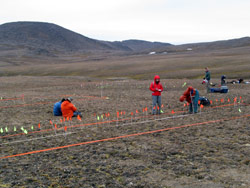 Microtopographic Transect. Students working along a microtopographic transect, studying the relationship between patterned ground features, vegetation, and invertebrate populations. Microtopographic Transect. Students working along a microtopographic transect, studying the relationship between patterned ground features, vegetation, and invertebrate populations.
Photo credit: Fred Daniels
|
|
|
|
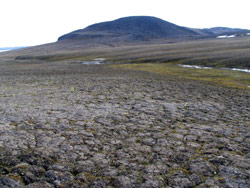 Typical Landscape in vicinity of Isachsen with small non-sorted polygons in the foreground. Slopes leading down to the creek have turf hummocks, and creek margin has wetland vegetation with weakly developed string hummocks. The hill in background is composed of diabase volcanic rocks, and most of the more gently rolling terrain is composed of colluvium derived from Christopher Shale. Typical Landscape in vicinity of Isachsen with small non-sorted polygons in the foreground. Slopes leading down to the creek have turf hummocks, and creek margin has wetland vegetation with weakly developed string hummocks. The hill in background is composed of diabase volcanic rocks, and most of the more gently rolling terrain is composed of colluvium derived from Christopher Shale.
Photo credit: Skip Walker
|
|
|
|
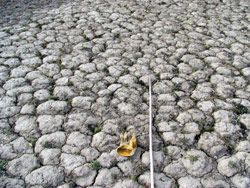 Small non-sorted polygons, 10-20 cm diameter, with strong cracking pattern developed on salty clayey soils derived from Christopher Shale. Small non-sorted polygons, 10-20 cm diameter, with strong cracking pattern developed on salty clayey soils derived from Christopher Shale.
Photo credit: Skip Walker
|
|
|
|
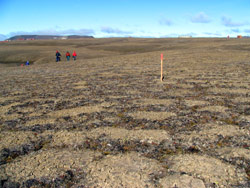 Larger non-sorted polygons, 30-50 cm diameter, with well-developed vegetation in the cracks between polygons. Larger non-sorted polygons, 30-50 cm diameter, with well-developed vegetation in the cracks between polygons.
Photo credit: Skip Walker
|
|
|
|
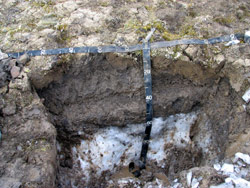 Soil pit in zonal vegetation. The active layer is about 35 cm. Massive ice at 55 cm is part of a very large ice wedge. Such wedges were commonly encountered in the soil pits on zonal sites. Soil pit in zonal vegetation. The active layer is about 35 cm. Massive ice at 55 cm is part of a very large ice wedge. Such wedges were commonly encountered in the soil pits on zonal sites.
Photo credit: Skip Walker
|
|
|
|
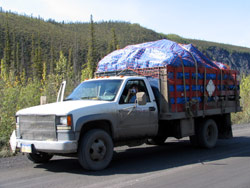 Expedition truck on return trip from Inuvik along the Dempster Highway. Expedition truck on return trip from Inuvik along the Dempster Highway.
Photo credit: Skip Walker
|
|
|
|
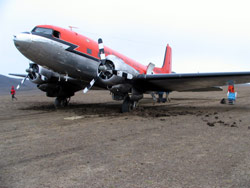 DC-3 Plane stuck in the mud on the Isachsen runway. Five Twin Otter flights were required to bring the equipment and people into Isachsen. The DC-3 was planned to reduce the number of Twin Otter flights required on the return trip, but this proved to be a mistake. During the days prior to this picture, the previously dry runway had developed wet patches due to water wicking up from the permafrost table. This condition went unnoticed until the DC-3 tried to turn on a soft spot. Once the plane was stuck, vibration from the engines caused the wheels to sink deeper until they contacted the permafrost table. DC-3 Plane stuck in the mud on the Isachsen runway. Five Twin Otter flights were required to bring the equipment and people into Isachsen. The DC-3 was planned to reduce the number of Twin Otter flights required on the return trip, but this proved to be a mistake. During the days prior to this picture, the previously dry runway had developed wet patches due to water wicking up from the permafrost table. This condition went unnoticed until the DC-3 tried to turn on a soft spot. Once the plane was stuck, vibration from the engines caused the wheels to sink deeper until they contacted the permafrost table.
Photo credit: Skip Walker
|
|
|
|
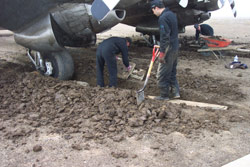 DC-3 Plane stuck in the mud. The final solution required digging down to permafrost and building a solid low-angle ramp consisting of planks overlaid with concrete blocks (one block is being handled by one of the pilots). These blocks were previously supports for runway markers along both sides of the runway. DC-3 Plane stuck in the mud. The final solution required digging down to permafrost and building a solid low-angle ramp consisting of planks overlaid with concrete blocks (one block is being handled by one of the pilots). These blocks were previously supports for runway markers along both sides of the runway.
Photo credit: Chien-Lu Ping
|
|



























